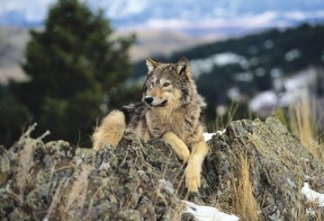Ganging up to grab more food
Food-snitching birds may drive wolves to hunt in large packs.
By Emily Sohn
In a famous fairy tale, the Big Bad Wolf meets a girl named Little Red Riding Hood and tries to eat her up. In real life, the behavior of birds (not little girls) may shape the way wolves hunt. This surprising conclusion comes out of a long-term study of wolves on an island in Lake Superior.
 |
|
When gray wolves hunt big prey, such as moose, group living may give the wolves more to eat amid food-snitching birds.
|
It seems to make sense for wolves to hunt alone or in pairs. Chasing down a moose, for example, takes a lot of energy, no matter how large the pack that hunts it may be. But, with only a two-way split, the rewards are greater for a pair of wolves than they are for a large pack. A pair doesn’t have to hunt as often as a large pack, which has more mouths to feed. Nonetheless, wolves usually hunt in packs of six or more.
After 27 winters spent observing wolves, researchers from Ohio and Michigan say they have an explanation. Hunting in packs may help wolves keep the hard-won meat of their prey away from the beaks of greedy scavenger birds such as ravens.
Moose are so big that just two wolves can’t eat one all at once after they’ve killed it. Within minutes of a kill, ravens show up and start hauling off any meat they can grab.
A pair of wolves loses an average of 37 percent of a carcass to ravens, the study showed. A pack of six loses just 17 percent. The researchers suggest that, by eating in a big pack, wolves gobble meat quickly, reducing a raven’s chance of stealing a meal.
So, Little Red Riding Hood may have been lucky that the wolf she ran into was alone and not part of a pack. Of course, anything can happen in fairy tales.







